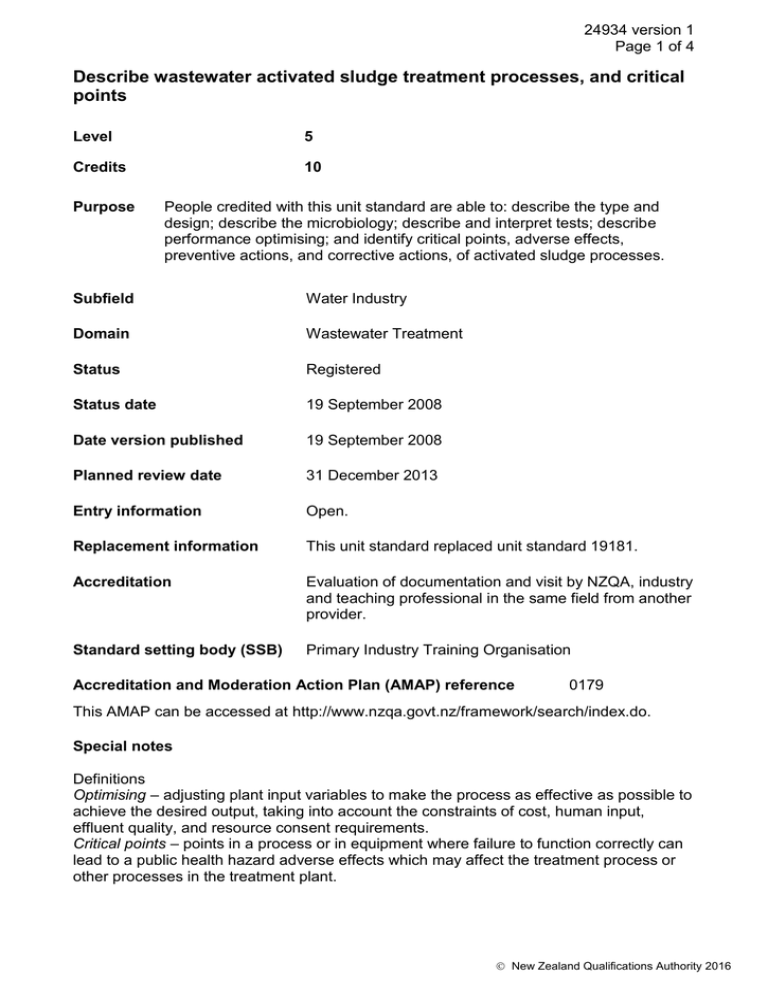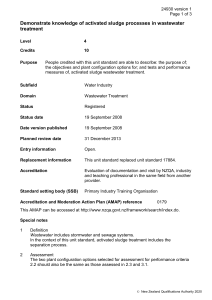Describe wastewater activated sludge treatment processes, and critical points
advertisement

24934 version 1 Page 1 of 4 Describe wastewater activated sludge treatment processes, and critical points Level 5 Credits 10 Purpose People credited with this unit standard are able to: describe the type and design; describe the microbiology; describe and interpret tests; describe performance optimising; and identify critical points, adverse effects, preventive actions, and corrective actions, of activated sludge processes. Subfield Water Industry Domain Wastewater Treatment Status Registered Status date 19 September 2008 Date version published 19 September 2008 Planned review date 31 December 2013 Entry information Open. Replacement information This unit standard replaced unit standard 19181. Accreditation Evaluation of documentation and visit by NZQA, industry and teaching professional in the same field from another provider. Standard setting body (SSB) Primary Industry Training Organisation Accreditation and Moderation Action Plan (AMAP) reference 0179 This AMAP can be accessed at http://www.nzqa.govt.nz/framework/search/index.do. Special notes Definitions Optimising – adjusting plant input variables to make the process as effective as possible to achieve the desired output, taking into account the constraints of cost, human input, effluent quality, and resource consent requirements. Critical points – points in a process or in equipment where failure to function correctly can lead to a public health hazard adverse effects which may affect the treatment process or other processes in the treatment plant. New Zealand Qualifications Authority 2016 24934 version 1 Page 2 of 4 Organisational procedures – instructions to staff, and procedures which are documented in memo or manual format and are available in the workplace. These requirements include but are not limited to – site specific requirements, manufacturers’ specifications, product quality specifications, and legislative or regulatory requirements. Wastewater includes stormwater and sewage systems. In the context of this unit standard, activated sludge treatment includes the separation process. Elements and performance criteria Element 1 Describe the type and design of activated sludge processes. Performance criteria 1.1 Activated sludge processes are described in terms of their type and design. Range 1.2 The recycling of solids is described in terms of solids concentrations. Range 1.3 conventional activated sludge, extended aeration, biological nutrient removal. mixed liquor suspended solids, the return of activated sludge, sludge volume index, sludge age during the process. The introduction of dissolved oxygen into the process is described in terms of process operation. Range process types – surface aeration, diffused aeration. Element 2 Describe the microbiology of activated sludge processes. Range loading rates, sludge volume index. Performance criteria 2.1 The micro-organisms in activated sludge wastewater treatment are identified and described in terms of their functions and effects. Range 2.2 functions – sludge bulking, burnout, filamentous bacteria, biological and physical processes; food to micro-organism ratio. Microbiological activity which affects process parameters is described. Range oxidation, sludge volume and density indices, sludge age, enzyme addition, pH effects. New Zealand Qualifications Authority 2016 24934 version 1 Page 3 of 4 Element 3 Describe and interpret tests of activated sludge processes. Performance criteria 3.1 Activated sludge processes are described in terms of the timing and types of tests to be undertaken. Range 3.2 tests include but are not limited to – pH, suspended solids, phosphorus, nitrogen, Biochemical Oxygen Demand (BOD), temperature, dissolved oxygen, microscopic evaluation, mixed liquor, sludge volume index, settleability. Test results are interpreted in relation to process variations. Range loading, time, environmental manipulation. Element 4 Describe performance optimising of activated sludge processes. Performance criteria 4.1 Results of monitoring are described in terms of the adjustments that may be carried out. Element 5 Identify critical points of activated sludge processes, adverse effects, preventive actions, and corrective actions. Performance criteria 5.1 The critical points in activated sludge processes are identified in accordance with organisational procedures. 5.2 The adverse effects at each critical point are identified in terms of the causes or the events leading to their occurrence. 5.3 The preventive and corrective actions for problems or events related to each adverse effect are identified. Please note Providers must be accredited by NZQA, or an inter-institutional body with delegated authority for quality assurance, before they can report credits from assessment against unit standards or deliver courses of study leading to that assessment. Industry Training Organisations must be accredited by NZQA before they can register credits from assessment against unit standards. New Zealand Qualifications Authority 2016 24934 version 1 Page 4 of 4 Accredited providers and Industry Training Organisations assessing against unit standards must engage with the moderation system that applies to those standards. Accreditation requirements and an outline of the moderation system that applies to this standard are outlined in the Accreditation and Moderation Action Plan (AMAP). The AMAP also includes useful information about special requirements for organisations wishing to develop education and training programmes, such as minimum qualifications for tutors and assessors, and special resource requirements. Comments on this unit standard Please contact the Primary Industry Training Organisation standards@primaryito.ac.nz if you wish to suggest changes to the content of this unit standard. New Zealand Qualifications Authority 2016



